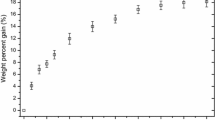Abstract
When wood undergoes an acidic or alkaline chemical action or a moderate thermal action, acetyl groups are easily removed. As deacetylation favourably increases the accessibility of the cell wall and the fibre swelling, mechanical properties of wood and responses of wood to pulping are modified. In this paper, the importance of the deacetylation effects in alkaline pulping is highlighted. It is shown that it is very useful to analyse acetyl content profiles in eucalyptus wood for determining the level of alkali impregnation. Global deacetylation can be a parameter that can be practical for determination of the effectiveness of alkaline impregnation of chips. In alkaline chemi-mechanical pulping of poplar, the deacetylation level that takes place during pre-treatment can establish the bonding capacity of the pulp developed afterwards in the refiner. Acetyls can be very reactive under conditions of peroxide bleaching of chemi-mechanical pulps and, as a consequence of this reaction, alkali concentration in the process and final pulp properties can be notably affected.
Zusammenfassung
Wenn Holz einer sauren oder alkalischen chemischen Behandlung oder einer gemäßigten thermischen Behandlung unterworfen wird, werden Acetylgruppen leicht abgespalten. Da eine Deacetylierung vorteilhaft die Zugänglichkeit der Zellwand und die Faserquellung erhöht, werden die mechanischen Eigenschaften des Holzes und das Verhaltung des Holzes beim Aufschluss verändert. In dieser Arbeit wird die Bedeutung der Deacetylierung beim alkalischen Zellstoffaufschluss hervorgehoben. Es wird gezeigt, dass es sehr nützlich ist, Profile des Gehalts an Acetylgruppen in Eukalyptusholz zum Bestimmen des Ausmaßes der Imprägnierung mit Alkali zu analysieren. Die Gesamt-Deacetylierung kann ein Parameter sein, der nützlich ist, die Wirksamkeit der alkalischen Imprägnierung der Späne festzulegen. Im alkalischen chemo-mechanischem Aufschluss von Pappelholz kann das Deacetylierungsniveau während der Vorbehandlung die spätere Bindungskapazität des Zellstoffs im Refiner bestimmen. Acetylgruppen können sehr reaktiv sein unter den Bedingungen der Peroxydbleiche des chemo-mechanischen Zellstoffs, und als Folge dieser Reaktion können die Alkalikonzentration im Prozess sowie die Eigenschaften des resultierenden Zellstoffs beeinflusst werden.





Similar content being viewed by others
References
Fengel D (1984) Wood chemistry, ultraestructure, reactions. Walter de Gruyter 118–120
Godoy R, Battinardi F, Dippold R, Fontana J, Ramos L (2001) Evaluation of the phosphoric acid-catalyzed steam explosion sugarcane bagasse through 23 experimental design. In: 7th Brazilian symposium on the chemistry of lignins and other wood components. Bello Horizonte, Brazil. Poster Presentation, pp 169–177
Harris J (1978) Process alternatives for furfural production. Tappi J 61(1):41–44
Roffael E, Dix B (1994) Veränderung im Acetylguppengehalt von Buchen-und Kiefernholz durch thermo-mechanischen (TMP) und chemo-thermo-mechinschen (CTMP) Ausfschluß sowie Herstellung von MDF. Holz Roh- Werkstoff 52:407–408
Sjöström E (1993a) Wood chemistry. Fundamentals and applications. Academic, New York, p 163
Sjöström E (1993b) Wood chemistry. Fundamentals and applications. Academic, New York, p 137
Sjöström E, Janson J, Haglund P, Enström B (1965) The acidic groups in wood and pulp as measured by ion exchange. J Polym Sci 11:221–241
Solár R, Casik F, Melcer Y (1987) Simple semimicro method for the determination of O-acetyl groups in wood and related materials. Nord Pulp Pap Res J 2(4):139–141
Sumi Y, Hale R, Meyer J, Leopold B, Ranby B (1964) Accessibility of wood and wood carbohydrates measured with titriated water. Tappi J 47(10):621–624
Thornton J (1993) Dissolved and colloidal substances in the production of wood-containing paper. Thesis. ÅboAkademi University
Thornton J, Eckerman C, Ekman R (1991) Effects of peroxide bleaching of spruce TMP on dissolved and colloidal organic substances. In: 6th international symposium on wood pulping chemistry proceedings. Appita 1:571–577
Thornton J, Ekman R, Holmbom B, Örsa F (1994a) Polysaccharides dissolved from Norway spruce in thermomechanical pulping and peroxide bleaching. J Wood Chem Technol 14(2):176–194
Thornton J, Tenkanen M, Ekman R, Holmbom B, Viikari L (1994b) Possibility of increasing mechanical pulp yield by enzymatic treatment. Holzforschung 48(5):436–440
Zanuttini M (1991) Effects of alkali charge in bagasse chemimechanical pulping. Part 2. Handsheet properties. Appita 44(2):257–260
Zanuttini M, Marzocchi V (1997) Kinetics of alkaline deacetylation of poplar wood. Holzforschung 51(3):251–256
Zanuttini M, Citroni M, Martínez M, Marzocchi V (1999) Alkaline treatment of poplar wood. Holz Roh-Werststoff 57:185–190
Zanuttini M, Citroni M, Marzocchi V (2000) Pattern of alkaline impregnation of poplar wood at moderate conditions. Holzforschung 54(6):636–639
Zanuttini M, Marzocchi V, Citroni M, Mocchiutti P (2003) Alkali impregnation of Hardwoods. Part I: moderate treatment of poplar wood. JPPS 29(9):313–317
Acknowledgements
Financial support was granted by the UNL through the CAI+D program, and also by the ANPCyT through a PICT 99.
Author information
Authors and Affiliations
Corresponding author
Rights and permissions
About this article
Cite this article
Zanuttini, M., Marzocchi, V., Mocchiutti, P. et al. Deacetylation consequences in pulping processes. Holz Roh Werkst 63, 149–153 (2005). https://doi.org/10.1007/s00107-004-0557-z
Published:
Issue Date:
DOI: https://doi.org/10.1007/s00107-004-0557-z




